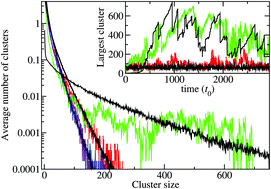Controlling the structure and mixing properties of anisotropic active particles with the direction of self-propulsion
Abstract
In the search for advanced materials active particles could offer unique structural and functional properties, with tunable time-dependent characteristics. We demonstrate here that the direction of self-propulsion, relative to the particle orientation, may be as influential for the phase behavior as the pair interactions are for passive particles, and enable dynamic properties that are not available to passive systems. We perform simulations on ensembles of self-propelled squares, and find that squares that self-propel in the direction perpendicular to a side rapidly reach a steady state with a characteristic cluster distribution, positional order, and well-defined diffusion constant. After tuning the direction towards a corner, the particles form large and dense clusters that show a transient collective motion, and display remarkable fluctuations over long time scales, with a distinct periodicity. Clusters of these particles appear unstable beyond a critical size, and susceptible to a catastrophic disintegration. Directionality is found to effect equally sharp transitions in the mixing properties of active squares and passive squares, and the behavior of the passive ensemble. We relate directionality to the collision dynamics and the resulting reaction network of clusters, evolved by a Kinetic Monte Carlo algorithm, to correlate propulsion direction to the observed phase behavior. Understanding this behavior could offer new design rules for programmable materials, and grant further insights in the dynamic processes that nature employs for self-assembly.



 Please wait while we load your content...
Please wait while we load your content...